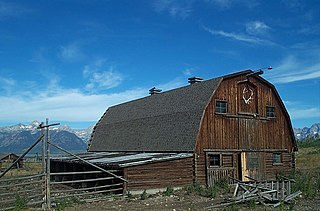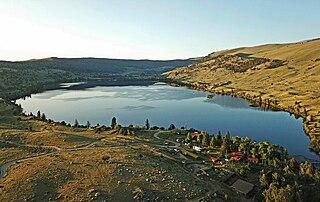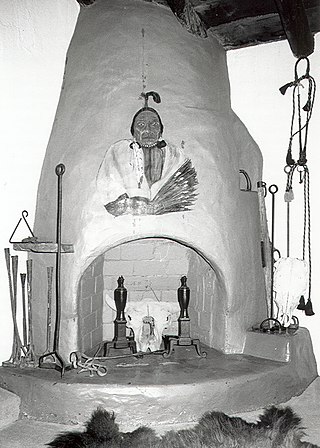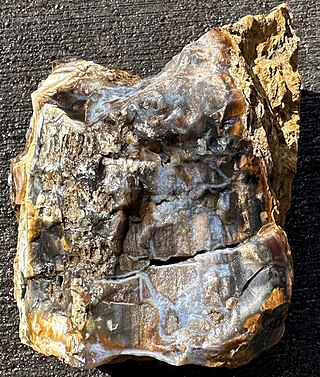
Buckeye is a farming and ranching unincorporated community in north central Larimer County, Colorado, United States. Bounded on the west by the 16,500-acre (67 km2) Roberts Ranch, the area includes Red Mountain Open Space to the north, Rawhide flats to the east, and extends south to Owl Canyon.

The St. Elmo Historic District, or St. Elmo for short, is a neighborhood in the city of Chattanooga, Tennessee. It is situated in the southernmost part of Hamilton County within the valley of Lookout Mountain below the part of the Tennessee River known as Moccasin Bend. St Elmo is at the crossroads of two ancient Indian trails, and was first occupied by Native American hunters and gatherers in the Woodland period, then agricultural Mississippians, including Euchee and Muscogee, and for a brief period between 1776 and 1786, the Cherokees in a community called Lookout Town. St. Elmo became part of the city of Chattanooga when it was annexed in September 1929.

The Dog Iron Ranch, located about two miles east of Oologah, Oklahoma, United States, is a historic ranch which is the birthplace of humorist Will Rogers. It was donated to the State of Oklahoma by the Rogers family, and is now owned and operated by the Cherokee Nation. The current property comprises 400 acres (1.6 km2) of the original 60,000-acre (240 km2) ranch operated by Clem Rogers, Will's father. Originally the ranch contained up to 10,000 Texas Longhorn cattle. The present ranch has 50 Longhorns.

The AMK Ranch is a former personal retreat on the eastern shore of Jackson Lake in Grand Teton National Park. Also known as the Merymare, Lonetree and Mae-Lou Ranch, it was a former homestead, expanded beginning in the 1920s by William Louis Johnson, then further developed in the 1930s by Alfred Berol (Berolzheimer). Johnson built a lodge, barn and boathouse in 1927, while Berol added a larger lodge, new boathouse, and cabins, all in the rustic style.

The Minnie Hill Palmer House, also known as The Homestead Acre, is the only remaining homestead cottage in the San Fernando Valley. The cottage is a redwood Stick-Eastlake style American Craftsman-Bungalow located on a 1.3-acre (0.53 ha) site in Chatsworth Park South in the Chatsworth section of Los Angeles, California.

The Manges Cabin in Grand Teton National Park, also known as the Old Elbo Ranch Homestead Cabin, Mangus Cabin and the Taggart Creek Barn, was built in 1911 by James Manges. Manges was the second settler on the west side of the Snake River after Bill Menor, setting up a homestead near Taggart Creek. James Manges arrived in Jackson Hole in 1910, where he cut wood for Charles or William Wort. Manges' cabin is stated to have been the first two-story structure in the northern part of the valley. A root cellar was excavated beneath. The log and frame structure features wide eaves to keep the winter snow away from the walls. It was heated in winter by a single stove, with one room on each level.

The Hunter Hereford Ranch was first homesteaded in 1909 by James Williams in the eastern portion of Jackson Hole, in what would become Grand Teton National Park. By the 1940s it was developed as a hobby ranch by William and Eileen Hunter and their foreman John Anderson. With its rustic log buildings it was used as the shooting location for the movie The Wild Country, while one structure with a stone fireplace was used in the 1963 movie Spencer's Mountain. The ranch is located on the extreme eastern edge of Jackson Hole under Shadow Mountain. It is unusual in having some areas of sagebrush-free pasture.

The Buckner Homestead Historic District, near Stehekin, Washington in Lake Chelan National Recreation Area incorporates a group of structures relating to the theme of early settlement in the Lake Chelan area. Representing a time period of over six decades, from 1889 to the 1950s, the district comprises 15 buildings, landscape structures and ruins, and over 50 acres (200,000 m2) of land planted in orchard and criss-crossed by hand-dug irrigation ditches. The oldest building on the farm is a cabin built in 1889. The Buckner family bought the farm in 1910 and remained there until 1970, when the property was sold to the National Park Service. The Buckner Cabin was listed on the National Register of Historic Places in 1974. The rest of the Buckner farm became a historic district in 1989. Today, the National Park Service maintains the Buckner homestead and farm as an interpretive center to give visitors a glimpse at pioneer farm life in the Stehekin Valley.

The James Cant Ranch is a pioneer ranch complex in Grant County in eastern Oregon, United States. The ranch is located on both sides of the John Day River in the John Day Fossil Beds National Monument. The ranch was originally homesteaded by Floyd Officer in 1890. Officer sold the property to James Cant in 1910. Cant increased the size of the property and built a modern ranch complex on the west bank of the river. The National Park Service bought the ranch from the Cant family in 1975, and incorporated the property into the John Day Fossil Beds National Monument. The National Park Service used the main house as a visitor center until 2003. Today, the Cant Ranch complex is preserved as an interpretive site showing visitors an early 20th-century livestock ranch. The James Cant Ranch is listed on the National Register of Historic Places.

The Sod House Ranch is a historic ranch in Harney County in southeastern Oregon, United States. The remaining ranch structures are located south of Malheur Lake in the Malheur National Wildlife Refuge. The ranch was built by Peter French, a well known 19th-century cattle baron. The Sod House Ranch became the headquarters for the northern operating division of the French-Glenn Livestock Company, which eventually covered over 140,000 acres (570 km2). After French was murdered in 1897, the French-Glenn Livestock Company slowly sold off its ranch property. In 1935, the United States Government purchased the Sod House Ranch property to add to an adjacent wildlife refuge. The eight remaining Sod House Ranch buildings are now listed on the National Register of Historic Places.

The Brainerd Mission was a Christian mission to the Cherokee in present-day Chattanooga, Tennessee. The associated Brainerd Mission Cemetery is the only part that remains, and is listed on the National Register of Historic Places.
The Flying Horseshoe Ranch was established in the Centennial Valley of southeastern Wyoming by Danish immigrant Mads Wolbol in the late 1870s. The complex of mostly log structures, about 15 of which are considered contributing structures.

The Torrey Lake Club or Torrey Lake Ranch, also known as the Boardman Ranch or Murdock Ranch was built as a resort in the 1920s about 8 miles (13 km) southeast of Dubois, Wyoming. at an elevation of about 7,400 feet (2,300 m).The club is on about 603 acres (244 ha), centered on a complex of nine cabins, a bunkhouse for ranch hands and staff, and supporting structures. The log cabins were built by club members from local materials.

Remount Ranch, in Laramie County, Wyoming near Cheyenne, Wyoming, is a pioneer cattle and horse ranch which dates from 1875. It was listed on the National Register of Historic Places in 1990. The listing included four contributing buildings and four contributing structures.

The Juan Cristobal Armijo Homestead, at 207 Griegos Rd., NE in Albuquerque, New Mexico, was built in 1875. It was listed on the New Mexico State Register of Cultural Properties in 1978 and the National Register of Historic Places in 1982. The listing included four contributing buildings and a contributing structure on 9.5 acres (3.8 ha).
Stewart Ranch, also known as Stewart-Hewlett Ranch, near Woodland, Utah in Wasatch and Summit counties, includes eight buildings which were separately listed on the National Register of Historic Places in 1985. The former ranch is located off Utah State Route 35. Some or all of the ranch is included in what is now the Diamond Bar X Ranch.
The Salt Works Ranch, at 3858 U.S. Route 285 in Park County, Colorado near Hartsel, Colorado, was founded in 1862. The land is unusual for the presence of saline springs. It was listed on the National Register of Historic Places in 2001.

Daniels Park is a former working ranch in Douglas County, Colorado, United States. The park is one of the Denver Mountain Parks and was listed on the National Register of Historic Places in 1995. It is located along Douglas County Road 67 northeast of Sedalia and east of Castle Pines. The modern-day park may have been the site of Kit Carson's last campfire and includes a memorial to the frontiersman.
Mildred Montague Genevieve "Tweet" Kimball, was an American rancher, art collector, and heiress who owned and lived on the 3,400-acre Cherokee Ranch and its associated castle north of Sedalia in Douglas County, Colorado, from 1954 until her death. Born to a wealthy Tennessee family and raised in Chattanooga, Kimball moved to Colorado following her divorce from diplomat husband Merritt Ruddock.

A large petrified forest thought to date to the Paleocene at around 55 million years old is located on and around the grounds of Cherokee Ranch in Douglas County, Colorado. These Denver Basin fossils include plants similar to the modern laurel tree family. At least 40 large petrified logs have been discovered on the Cherokee Ranch property; the castle on the ranch site includes more than 4,000 pieces of petrified wood in its construction.

















